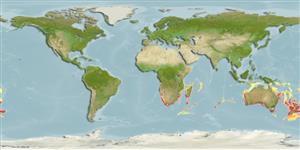Élasmobranches (requins et raies) (sharks and rays) >
Squaliformes (Sleeper and dogfish sharks) >
Centrophoridae (Gulper sharks)
Etymology: Deania: -ia (Gr.), belonging to: American ichthyologist Bashford Dean (1867-1928), American Museum of Natural History, for his research on selachian fishes. (See ETYFish); quadrispinosa: quadri-, from quattuor (L.), four; spinosa (L.), thorny, referring to four-spined dermal denticles. (See ETYFish).
Environment: milieu / climate zone / depth range / distribution range
Écologie
marin bathydémersal; profondeur 150 - 1360 m (Ref. 44037), usually 400 - 820 m (Ref. 6871). Deep-water; 9°S - 54°S, 12°E - 172°W (Ref. 54349)
Southeast Atlantic: off Namibia and off Algoa Bay, South Africa. Indo-West Pacific: off southern Mozambique and Natal, South Africa; Australia and New Zealand (Ref. 6871).
Length at first maturity / Taille / Poids / Âge
Maturity: Lm ?, range 110 - ? cm
Max length : 115 cm TL mâle / non sexé; (Ref. 6871)
Épines dorsales (Total) : 2; Épines anales: 0. Extremely long snout, grooved dorsal fin spines, compressed cutting teeth in both jaws, moderately large, pitchfork-shaped denticles, no subcaudal keel on underside of caudal peduncle, first dorsal fin short and high (Ref. 247). Dark brown, grey, or black in color; juveniles with a dark blotch on each dorsal fin (Ref. 26346).
A rare (Ref. 26346) and little-known species found on outer continental shelves and upper slopes (Ref. 247). Feeds on bony fishes (Ref. 247). Ovoviviparous (Ref. 50449).
Life cycle and mating behavior
Maturities | Reproduction | Spawnings | Egg(s) | Fecundities | Larves
Ovoviviparous, embryos feed solely on yolk (Ref. 50449). Distinct pairing with embrace (Ref. 205).
Compagno, L.J.V., 1984. FAO Species Catalogue. Vol. 4. Sharks of the world. An annotated and illustrated catalogue of shark species known to date. Part 1 - Hexanchiformes to Lamniformes. FAO Fish. Synop. 125(4/1):1-249. Rome, FAO. (Ref. 247)
Statut dans la liste rouge de l'IUCN (Ref. 130435)
Menace pour l'homme
Harmless
Utilisations par l'homme
Pêcheries: intérêt commercial mineur
Outils
Articles particuliers
Télécharger en XML
Sources Internet
Estimates based on models
Preferred temperature (Ref.
123201): 5.5 - 12.3, mean 8.2 °C (based on 236 cells).
Phylogenetic diversity index (Ref.
82804): PD
50 = 0.5625 [Uniqueness, from 0.5 = low to 2.0 = high].
Bayesian length-weight: a=0.00263 (0.00121 - 0.00572), b=3.18 (2.99 - 3.37), in cm total length, based on LWR estimates for this (Sub)family-body shape (Ref.
93245).
Niveau trophique (Ref.
69278): 4.5 ±0.80 se; based on food items.
Résilience (Ref.
120179): Faible, temps minimum de doublement de population : 4,5 à 14 années (Fec assumed to be <100).
Fishing Vulnerability (Ref.
59153): High to very high vulnerability (69 of 100).
